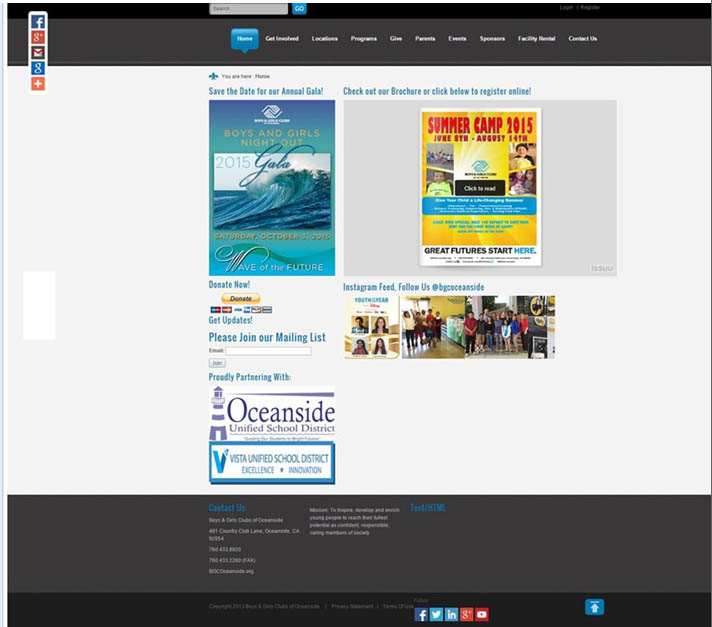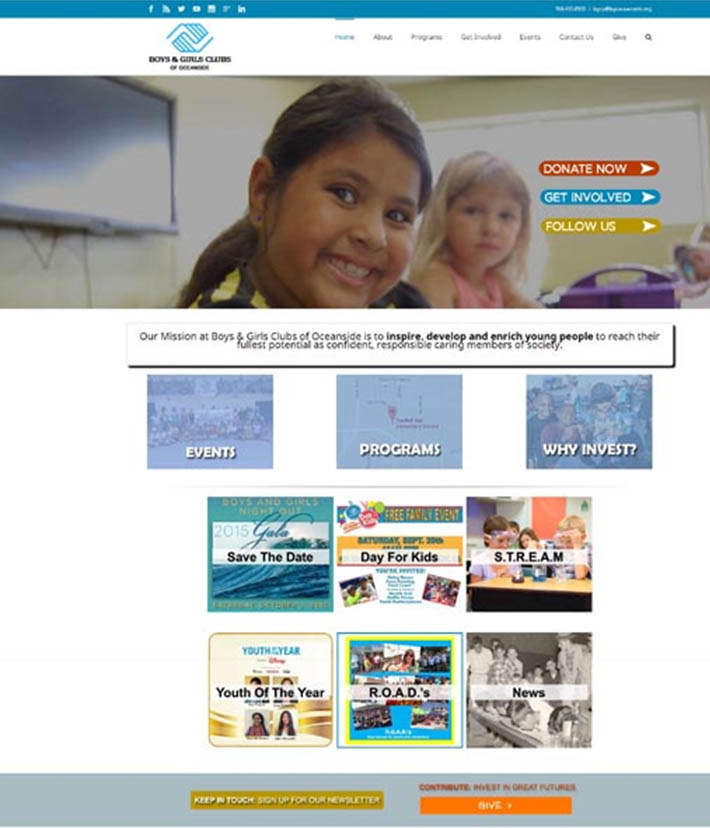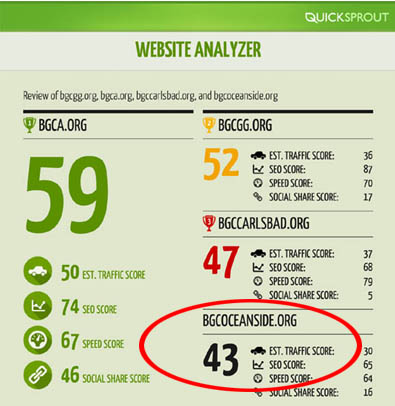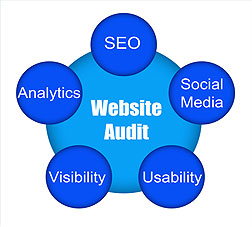Based on more than 15 years experience helping hundreds of companies redesign their websites, we’ve seen redesigns that were immensely successful, while a few simply failed. We’ve compiled 5 keys for a successful website redesign in order to help others improve their redesign results. Keep in mind there are many factors to consider, but with these basic principles in place the odds of success increase significantly.
First let’s look at WHY you might want to redesign your website. The most important reasons to redesign are:
- Your website design is outdated and not mobile responsive.
- Your website content is incorrect, changed or missing important information.
- Your website does not have a competitive advantage in your marketplace.
- Your website performance is sub-par, produces errors and/or is not effective at converting prospects.
Case Study:

Boys & Girls Clubs of Oceanside (BGCO) – http://bgcoceanside.org/
CASE STUDY NOTE: When the BGCO first contacted us their website suffered from all of the above. Below are BEFORE and AFTER screen shots of the BGCO website, followed by BEFORE and AFTER Website analysis Reports.
BGCO Website BEFORE Redesign:

BGCO Website AFTER Redesign:

BEFORE: Website Analysis Score of 43, the LOWEST compared to any other Boys & Girls Clubs in the region:

AFTER: Website Analysis Score of 54, the HIGHEST compared to any other Boys & Girls Clubs in the region:

The 5 Keys For a Successful Website Redesign
After determining why you want to redesign, it’s time for these five KEY Planning, Design and Marketing principles:
KEY #1: Effective Development Team.

All great redesigns start with combining the client’s in-depth knowledge of their industry and USP with internet marketing expert knowledge in online best practices, a creative content developer (graphics, video, etc) and an organizer/coordinator to keep everyone on the team updated, accountable and on track. A project that does not have all of these team resources will likely suffer with less than effective results. While some team members can be responsible for multiple tasks, not all tasks can be handled by one person. At least not very well.
CASE STUDY NOTE: Our BGCO Team included the in-house Project Lead, Alexa Morr, Marketing/Public Relations for BGCO, as well as other key staff and leaders at BGCO, who provided valuable input on the goals and priorities for their website. Our consultant team was comprised of technical, design and marketing experts selected for their particular area of specialization. While it would have been difficult and costly for BGCO to recruit and build their own internal website team, by partnering with Amazeinc, we were able to provide the full spectrum of expertise on an as needed basis only. Thereby reducing the cost, time and frustration for the BGCO.
KEY #2: Determine Website Goals.

Clearly defined objectives with realistic expectations is crucial. Most websites fail because they don’t have clear or realistic goals. If you can’t compete against other huge players, then don’t try! Find a smaller, niche market where you can effectively compete and plan to dominate that market and then you can expand your market based on past successes, rather than wishful thinking. Goals should also be measurable and supported with the necessary resources (time, budget, decision-making). If you are unsure or unwilling to contribute the resources needed for the project, or are unable to completely delegate to another person, it would be better to postpone the project until it can be fully supported.
CASE STUDY NOTE: BGCO had very realistic goals and priorities for their website. As a non-profit they worked with us to establish the most cost-effective plan, including a willingness to be flexible about what could be accomplished in the short term versus long term goals. This made it easier for the development team to focus on the priorities rather than a list of desired bells and whistles based upon random personal preferences. Unfortunately many website projects end up failing when clear goals are not established and followed from the start. The focus on core goals was definitely KEY to the effective completion of the BGCO website revamp.
KEY #3: Research: Competitive Analysis, Keyword and Marketplace.

Typically you will learn more from this step than any other to position and target your website. Research helps define Keyword Priority, Calls to Action, SEO benchmarking, etc. Study your competition, not to simply copy them, but to gather ideas with the intent to adapt and improve upon what they are doing. Be smarter than your competition by learning everything you can about them. Benchmark your Current Status. Use analytics tools like Google Analytics and Google Search Console to document where you are now as a baseline for measuring how much ROI your new website produces. Determine target audience. Learn from major players – large, established websites have invested in usability studies to understand what works, rather than just following whatever design is trendy. Learn from their examples and adopt tactics for your own site.
CASE STUDY NOTE: BGCO assisted in the review of all facets of research and provided insightful feedback that enabled us to laser-focus the website content to their Target Market. As a RESULT, within 60 days of launching their revamped website their Google Organic Search Rankings increased 53%, the number of Search Keywords increased from 201 to 626 and the overall site engagement (page views) increased 24%. Compared to the other BG Clubs we benchmarked during this same time period, who had little to no increase in their results, the BGCO now has among the HIGHEST SEO scores, which increased by 17 points from 65 to 82.
KEY # 4. Develop Targeted Content Strategy.

Remember your redesign is not the end and ALWAYS target your audience. The primary goal of most websites is to convert visitors into customers. By demonstrating why your site provides the best solution for targeting your audience’s needs, it will prompt visitors to take action as soon as possible. Your website is not about you. It’s about your Target Audience. To succeed online, keep WIFM in mind! WIFM = What’s in it for ME? That is the question every website visitor wants answered and you have about 8 seconds to EFFECTIVELY answer it. How well does your current website accomplish that goal? The first step is to PLAN UPDATES. Create a content plan and calendar and then work that plan, so your new site stays fresh and yields increasingly better results over time.
CASE STUDY NOTE: BGCO eagerly agreed to a content plan focused on their Target Audience. Then based on our review of their budget and time frames we established a content plan strategy that addressed their immediate needs, while including the long term content growth into the new design structure. Thereby saving them the cost of developing all desired content within the initial re-launch, while ensuring an easy to expand navigational format for the long term content.
KEY # 5. Plan for Long Term Growth.

Most important KEY! Budget for website marketing and ongoing optimization. Do not simply set it and forget it! A website without a long term marketing plan is usually a very lonely place. Make sure you are the POPULAR website that everyone wants to visit! Sadly many website owners do not promote their online presence because they either don’t know how or had a bad experience and are now convinced that internet marketing “does not work for us”. The FACT is, website marketing is THE most cost-effective type of marketing and if it is not yours, then don’t give up, because it CAN be the best investment any business makes in their growth strategy.
CASE STUDY NOTE: The initial continuous improvement plan established for BGCO includes a range of long term growth tactics including; Content expansion for the website, Ad Campaign optimization, enhanced Social media marketing integration and targeted Landing pages for special events, news, etc. Since launching the revamped website at the end of August, we focused on testing and measuring results during September and now in October we have begun reviewing and modifying the initial plan and Action Items based on actual results.
SUMMARY: Deciding to redo your website requires an investment in both time and money. Follow these 5 Keys to reduce confusion and frustration while maximizing your return on investment. Keep in mind, there are many important factors in creating an effective internet presence. Make sure you take the time, make the plan, and invest the resources to ensure yours is a success!
FYI: Here’s a few other QUICK TIPS to a successful website design:
- KISS principle – Keep It Simple, Stupid! A website Home page should be clean, uncluttered, no flashing/blinking/busy content with well organized snippets of visually appealing content and more white space.
- Calls To Action (CTA) on every page – TEST CTA response by placing them in varying positions on the page. Prompt visitors to Sign-up, Download, Schedule, View (use ACTION verbs).
- Offer Multiple Media Content formats – By presenting content in different formats (Text, Images, Videos) you cater to people of all information styles and maximize potential visitor interaction.
- Test everything! The website, marketing plan, advertising campaigns, social media channels, etc. Test it, Track it, Measure it, Adjust it… Repeat to Infinity!
- Solid Technology Structure. Have your site built on a well-supported CMS like WordPress (no proprietary systems) and a choose a reliable hosting provider based on service, not price.
For more information, comments, questions, or to schedule a No Charge Website Analysis, visit our website at: http://amazeinc.com/. Or contact me through any of the channels below:
Lisa Frost
lf@amazeinc.com
760-754-8012
